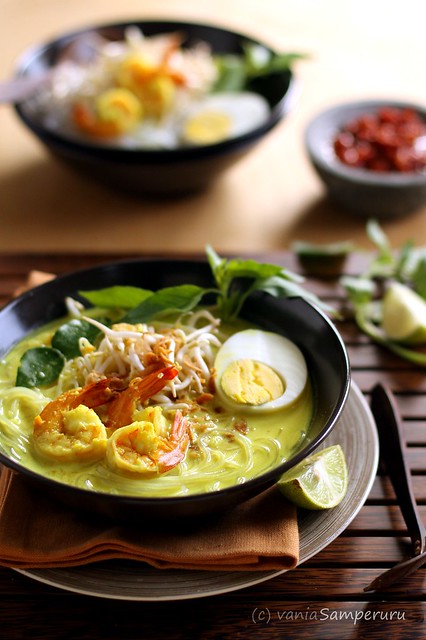Laksa is a popular spicy noodle soup from the Peranakan culture, which is a merger of Chinese and Malay elements found in Malaysia and Singapore, and to a lesser extent Indonesia.
Source : Wikipedia.
 We used to live in Malaysia for 3.5 years. So, I know 100% that laksa is indeed a popular dish in Malaysia. Not doubt! Other than that, I found out during the 'international day' in my children's previous school, the Singapore booth always sell Singaporean Laksa.
We used to live in Malaysia for 3.5 years. So, I know 100% that laksa is indeed a popular dish in Malaysia. Not doubt! Other than that, I found out during the 'international day' in my children's previous school, the Singapore booth always sell Singaporean Laksa.Yes, laksa is famous and popular in both countries, and it's popular in some part of our country, as well. During the Jakarta Fair, I did try Laksa Betawi (~Jakarta). Another popular Indonesian Laksa is called Laksa Pengantin from Bogor (West Java).
A couple of months ago, I read that there is famous laksa dish from a town called Cibinong. Cibinong is the capital of Bogor Residence in West Java. It's located between Jakarta and city of Bogor. To be honest, I never tried the original Laksa Cibinong, but I found the recipe of the dishes from one of my recipe books and decided to prove that it's delicious. For me, after trying some variants of Indonesian Laksa, I think they are similar each other (ahaa... I know, I don't have a sensitive tongue to recognize the differences!). Indonesian laksa is kind of thick yellowish coconut milk based soup, that is produced by mixture of some spices and salt, and it is served with bean sprout, vermicelli, shrimps, eggs, and Indonesian basil leaves. Sometime they are also served with coooked shredded chicken and glutinous rice cake (ketupat). Sound yummy, right!

There is no special requirement to cook this dish. Just remember, while cooking 'soup' using coconut milk, don't forget to stir occassionally to prevent the coconut milk from curdling.If you are not familiar with one of the ingredients; "temu mangga", ahaaa... let me tell you, that's the one which makes this dish fresh and it has unique flavour as well as giving soft yellow color to the dish. If you're in Jakarta, it's not hard to find this kind of fresh spice. The shape looks like somewhere between ginger and tumeric. Cut a little bit, ... you'll smell a young mango aroma. That's why they're called it temu mangga.Laksa Cibinong
Source : Primarasa, Hidangan Berkuah Terlezat
Bahan / Ingredients
75 gr bihun kering / 75 gr dried vermicelli
2 butir telur rebus / 2 boiled eggs
100 gr taoge / 100 gr bean sprouts
2 sdm minyak goreng / 2 tbsp oil
2 batang serai, memarkan / 2 lemon grass, crushed
6 lembar daun jeruk / 6 lime leaves
750 ml santan, dari 1/4 butir kelapa / 750 ml coconut milk from 1/4 coconut
100 gr udang ukuran sedang, kupas, belah punggungnya / 100 gr medium-size shrimp, peel, shallow slice its back longitudinally
1 sdt garam / 1 tsp salt
1/2 sdt merica bubuk / 1/2 tsp ground (white) pepper
1/2 sdt gula pasir / 1/2 tsp granulated sugar
1 sdm bawang goreng / 1 tbsp fried onions
2 tangkai daun kemangi / 2 stalks Indonesian basil leaves
Bumbu Halus / Spices (ground)
8 butir bawang merah / 8 shallots
3 siung bawang putih / 3 cloves garlic
2 butir kemiri / 2 candlenuts, roasted
1 sdt ketumbar sangrai / 1 tsp coriander, roasted
1/4 sdt jintan sangrai / 1/4 tsp cumin, roasted
1 cm kencur / 1 cm kaempferia galanga
2 cm kunyit bakar / 2 cm tumeric
3-4 cm temu mangga / 3-4 cm temu mangga
Pelengkap
Sambal cabai rebus / Chilli
Air jeruk nipis / Lime juice
 Cara memasak:
Cara memasak:1. Seduh bihun dengan air panas hingga lunak, tiriskan. Kupas telur, belah dua atau empat memanjang. Buang akar taoge, sisihkan.
2. Panaskan minyak goreng dalam wajan, tumis bumbu halus hingga harum, masukkan serai dan daun jeruk, aduk. Masukkan santan, masak hingga mendidih, timba-timba supaya santan tidak pecah.
3. Masukkan udang, tambahkan garam, merica, dan gula, aduk. Kecilkan apinya, masak hingga cukup matang, angkat.
4. Siapkan mangkuk saji, taruh bihun, taoge, dan telur ke dalam mangkuk. Siram kuah panas, taburi bawang goreng dan daun kemangi. Sajikan panas dengan sambal cabai rebus dan air jeruk nipis.
 Cooking Method :
Cooking Method :1. Blanch the dried vermicelli with hot water until tender, drain. Peel the eggs, cut lengthwise into two or four. Discard the roots of bean sprouts and set aside.
2. Heat oil in a skillet, saute ground spices until fragrant, put lemon grass and lime leaves, stir. Add the coconut milk. Heat it to the boil and stir occassionally to prevent the coconut milk from curdling.
3. Add the shrimp, salt, pepper, and sugar, stir. Reduce the heat and cook well, remove from the heat.
4. Prepare the serving bowls, place the vermicelli, bean sprouts, and eggs into a bowl. Pour hot gravy to cover these and sprinkle with fried shallots and basil leaves. Serve with boiled chili sauce and lime juice.
Have a good Thursday night!














